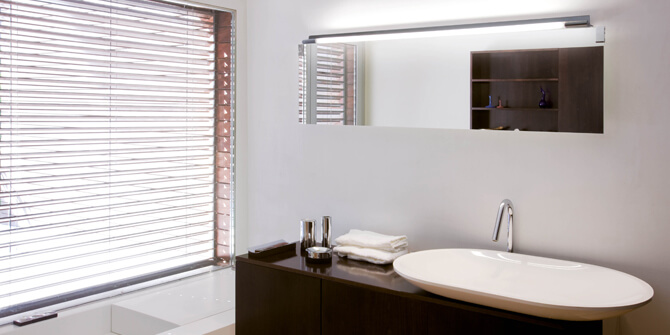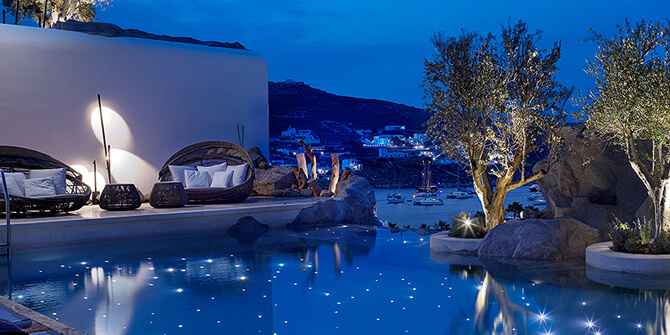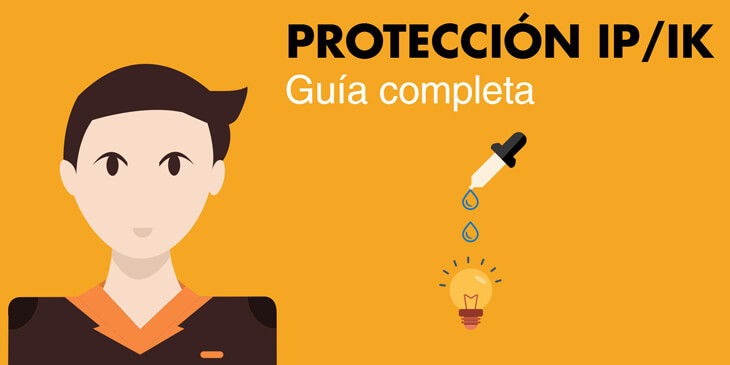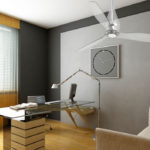If you have ever been interested or are interested in buying lighting products, you will have probably encountered the initials “IP” (IP protection rating) and “IK” (IK protection rating) on the product specification sheet.
It is very likely that you haven’t taken them into account when making your purchase.
If we want our product to last for as long as possible and we don’t want to spend more money than necessary, it’s a good idea to take these characteristics into consideration:
IP Protection Rating
The initials IP refer to “Ingress Protection” and indicate the level of protection the object provides against the entry of foreign materials, such as dust and water.
Its nomenclature is governed by IEC standard 60529 which, through symbols, establishes a series of indications, and is composed as follows:
IP-[Digit 1][Digit 2]
Digit 1: level of protection against the ingress of solid objects such as dust.
Digit 2: level of protection against water ingress.
IP Degrees of Protection Chart
We will divide it into two columns, according to the value of the first digit that indicates the protection against solid objects, and the value of the second digit that indicates the protection against water ingress.
| IP – Protection against the ingress of solid objects | IP – Protection against water ingress |
|---|---|
| 0 – No protection. | 0 – No protection. |
| 7 – Can handle full immersion in water for 30 minutes. | |
| 8 – Protection without any filtration when completely and continuously immersed at a depth and for an amount of time indicated by the manufacturer. |
1 – Protection against spherical bodies 50 millimetres in diameter. 1 – Protection against the vertical dripping of water at 200 millimetres for 10 minutes. 2 – Protection against spherical bodies 12.5 millimetres in diameter. 2 – Protection against dripping water inclined 15º vertically and horizontally. 3 – Protection against spherical bodies 12.5 millimetres in diameter. 3 – Protection against spray water at an angle of up to 60º to the right and left of the vertical. 4 – Protection against spherical bodies 1 millimetre in diameter. They should not be able to enter at all. 4 – Protection against water sprayed from any angle. 5 – Protection against dust, which should not enter in large quantities. 5 – Protection against jets of water sprayed from any angle. 6 – High protection against dust, which must not enter under any circumstances. 6 – Protection against very powerful jets of water sprayed from any angle.
DIN 40050-9 Standard
The German industrial standard DIN 40050-9 extends the rating system of IEC standard 60529.
It was designed for electrical or electronic equipment in road vehicles and for processes subject to attack by liquids and chemicals.
This German standard includes the “IP69K” rating that requires those products that have this rating to be able to resist ingress of high temperature and high pressure water.
How to Correctly Choose My Lamp According to Its Use
Once we know what these protection ratings mean and their levels, we can choose our products based on how we will use them.
Next we will classify the different types of use
Indoor installation
Those lamps that are to be installed inside of the home and will not come into contact with water do not need to have an IP level of protection.
Many manufacturers offer their products for indoor use with an IP20 level of protection that protects them against incoming objects measuring 12.5 mm in diameter.
Interior lighting exposed to moisture
Those light fixtures that are going to be placed in damp areas of the house such as bathrooms need a minimum level of protection. In the case of light fixtures installed on the wall (wall lights or mirrors), they will need a minimum of IP44 protection.

Those light fixtures that are going to be placed in damp areas of the house such as bathrooms need a minimum level of protection. In the case of light fixtures installed on the wall (wall lights or mirrors), they will need a minimum of IP44 protection.
Outdoor covered lighting
For roofed areas where you want to install a light fixture that will not have water fall on it, you can opt for a light fixture with an IP23 level of protection.
Uncovered outdoor lighting
Light fixtures that are going to be placed outside and that rain will fall on must have minimum of IP44 protection.
Submersible and marine environment products
For areas near the sea and products that we want to submerge underwater, maximum care should be taken. You should always opt for light fixtures with a minimum IP68 level of protection, which guarantees their proper functioning.

IK Protection Rating
This is a numerical classification, governed by the IEC 62262 standard that indicates an object’s degree of protection against external mechanical impacts. Before the standard arrived, a third number was usually added to the degree of IP protection to indicate the object’s impact resistance.
IK Degrees of Protection Chart
Next we will show a table with the level of IK protection (associated with impact energy), measured in joules.
| IK code | Impact energy (joules) |
|---|---|
| 00 | No protection |
| 07 | Resistance to an impact energy of 2 joules. |
| 08 | Resistance to an impact energy of 5 joules. |
| 09 | Resistance to an impact energy of 10 joules. |
| 10 | Resistance to an impact energy of 20 joules. |
01 Resistance to an impact energy of 0.15 joules. 02 Resistance to an impact energy of 0.20 joules. 03 Resistance to an impact energy of 0.35 joules. 04 Resistance to an impact energy of 0.50 joules. 05 Resistance to an impact energy of 0.70 joules. 06 Resistance to an impact energy of 1 joules.
To correctly choose the degree of IK protection, we must take into account whether the light fixture is at risk of impact, and in that case know what kind of impact. For example, those models that are intended to be used as armchairs or tables should have an IK10 degree of protection.




